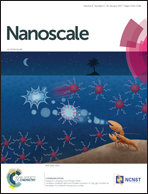Hot electron-driven hydrogen evolution using anisotropic gold nanostructure assembled monolayer MoS2†
Abstract
Plasmonic nanostructures attracting particular interest in plasmon-induced highly energetic electrons, also known as hot electrons, play a fundamental role in photocatalysis for solar energy conversion. Plasmon-induced hot electron excitation, relaxation, transport, and injection to two-dimensional semiconductors are necessary to clearly understand the efficient plasmon-induced chemical reaction. Herein, we use a plasmonic photocatalyst composed of anisotropic gold nanostructures as the electron donor assembled on two-dimensional molybdenum dichalcogenide, monolayer MoS2, as the electron acceptor in order to unveil the plasmon-induced interfacial hot electron transfer for the hydrogen evolution reaction (HER). Single-particle confocal fluorescence microscopy, computational calculation of finite-difference-time-domain (FDTD) simulation, and time-resolved transient absorption measurements revealed that anisotropic gold nanostructures with strong plasmon resonance exhibit interfacial hot electron transfer to monolayer MoS2, giving the charge separated state with a long lifetime of 800 ps which is responsible for efficient HER. This is the first example to show the plasmon-induced interfacial hot electron transfer from anisotropic Au nanostructures to two-dimensional materials.



 Please wait while we load your content...
Please wait while we load your content...